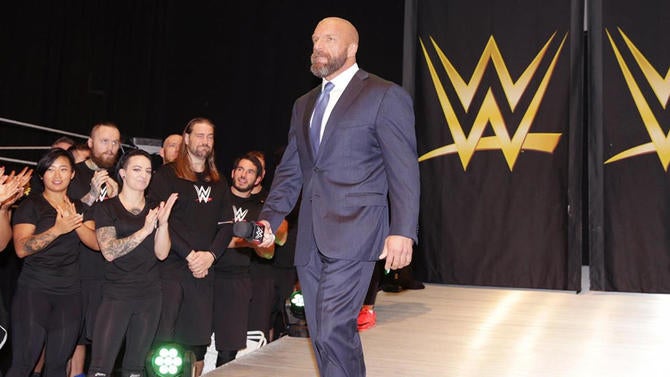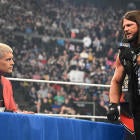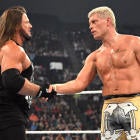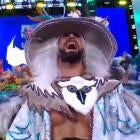
When WWE executive vice president Paul "Triple H" Levesque is looking for a litmus test to prove the success of the company's developmental system under his watchful eye, the 14-time world champion needs to look no further than the card set for WrestleMania 34 on Sunday, April 8 in New Orleans.
With 80 percent of WWE's current main roster having honed their craft on the yellow-and-black stage of the company's "third brand" in NXT, it has become increasingly difficult to mention a WrestleMania storyline on Raw or Smackdown that doesn't have a prominent NXT alumnus front and center.
"I think it speaks volumes to the system," Levesque told CBS Sports' In This Corner Podcast. "I think it speaks volumes that it worked and that it's still working. Obviously, I want it to improve and become better and better, but obviously it worked. Pretty much every match on the card at WrestleMania, I think with the exception of maybe one, have talent who came through the Performance Center. A lot of them have gone through NXT. It's definitely working."
NXT, WWE's developmental territory based in Orlando, Florida, opened its doors in 2012 after the company shut down its more bare bones Tampa-based Florida Championship Wrestling (FCW). Under the creative pencil of Levesque, the brand's patriarch, NXT has blended the styles of independent wrestling perfectly with that of WWE proper (along with a pinch of 1980s style booking to boot).
Big fan of WWE? Subscribe to our podcast -- In This Corner with Brian Campbell -- where we go in depth on everything you need to know in WWE each week.
To many of WWE's most passionate observers, dubbed "smart fans" or "smarks," NXT TakeOver, which takes place in New Orleans on April 7, has become just as anticipated as WrestleMania one night later, if not more in some cases.
Levesque, who rarely enters the ring these days outside of major events like WrestleMania, will play a major role in this year's card when he joins his wife, WWE chief brand officer and Raw commissioner Stephanie McMahon, against Kurt Angle and former UFC champion Ronda Rousey in a much-hyped tag team match. Yet, it's an easy guess to suggest the main focus for Levesque next weekend will be NXT's own Super Bowl card.
The first of these NXT specials was the only one in the series that didn't carry the TakeOver name. NXT Arrival, which aired live on Feb. 27, 2014, from the same tiny Full Sail University Arena that the brand calls home today, opened with a 23-minute Cesaro-Sami Zayn classic and ended with the first NXT championship ladder match between Neville and Bo Dallas.
Just three days after the WWE Network went live in the U.S., the card not only represented the first live wrestling show streamed on WWE's new platform, it marked in many ways the beginning of NXT developing the reputation as more than just a developmental brand that it holds today.
"If I had to pick one thing that I'm the most proud of is that [NXT] continues to roll," Levesque said. "When we did the first TakeOver and we had a series of call ups and we lose talent, everybody said, 'Ugh, this is the fatal flaw, you guys are done.' I tried to say to them, 'I don't think it's a flaw, I think it's the strength. It's on us to recreate, it's on us to keep it fresh and it's on us to keep it exciting.' I believe that the talent can do that."
If there was a period in NXT history where the depth of talent and quality of matches was at its peak, it would be fair to argue the first half of 2015. Looking back, the roster was almost gratuitously loaded with the likes of Kevin Owens, Zayn, Finn Balor, Samoa Joe, Neville, Tyler Breeze, Baron Corbin, Kalisto, Enzo Amore and Big Cass.
The names missing from that list may go down as the most important in NXT history as the Four Horsewomen -- Charlotte Flair, Sasha Banks, Bayley and Becky Lynch -- whose string of epic matches against each other literally changed the way WWE presents women's wrestling to this day.
"Does [NXT] have ebbs and flows? Absolutely," Levesque said. "When we lost the entire women's division except for Asuka, did it take us some time to reboot it? Absolutely. But that's the exciting part, watching the evolution and watching that talent grow to become something more.
"Our most passionate fan base are the fans that love NXT. Our most passionate fan base are the ones that can't get enough of in-ring product no matter what we do or what it is, they just love sports entertainment in general. When we can keep feeding that passion, that to me is the most exciting."
Listen to interviews with Triple H and Mauro Ranallo below, and be sure to subscribe to CBS Sports' In This Corner with Brian Campbell podcast.
With NXT constantly forced to reload and reboot, the roster currently stands at arguably its strongest since 2015, anchored by the likes of Andrade Almas, Aleister Black, Johnny Gargano, Ember Moon, The Undisputed Era and Velveteen Dream.
The secret to NXT's sustained strength, according to Levesque, is the state-of-the-art Performance Center which opened in July 2013, not far from where NXT is filmed in Orlando. The 26,000 square foot building, which includes seven rings and a world-class gym, serves as part wrestling college, injury rehab center and laboratory to create WWE's future stars.
Everything from cutting a promo and taking bumps off the top rope to nutrition and financial planning is taught at the PC. The concept has been so successful, it's hard not to see its influence in the new $14 million UFC Performance Institute which opened last year.
Yet for everything the PC has done in terms of molding and indoctrinating top independent stars and first-time wrestlers to the WWE way, it's long-term impact may not be seen for many years to come.
Levesque, who debuted in 1992 during the dying days of the pro wrestling territory system, has seen far too many of his contemporaries see their careers (and in many cases their lives) end prematurely due to the combination of excess drug use and undiagnosed head trauma. In some ways, the PC offers Levesque a chance to help change the everyday culture of the business to a more healthier status quo.
"It was as much of a focus as anything else," Levesque said. "I say this all the time when I'm at the Performance Center: 'This place, we create the business we want it to be. It doesn't matter what it is right now, it doesn't matter what it was 10 years ago. We are going to make it what we want it to be.'
"I looked at things then and there were times coming up through this business when it was the greatest thing in the world. And there were times when you could look at the business and say, 'Man, I just wish things weren't this way or I wish things weren't like this or I wish guys wouldn't do that. This is the kind of thing that embarrasses me that I even work with these other people or are part of this in some way.'"
Levesque, who credits the diversity of the NXT roster as one of the elements he's most proud of, has also been impressed by how many professionals who respect this business that the PC has created.
"When we have talent -- main roster, NXT, anywhere -- that go other places [in entertainment], I always get reports back from those people that, 'These are the most professional athletes I've ever worked with,'" Levesque said. "I'm really super proud of that. I see the level now of athlete that's here and the level that they put into this -- their health and their well-being and they are taking care of themselves and they rehab and do all of these things they need to do to have a long career. They are professionals and they act like professionals and they understand what that means and how to represent themselves and the company. I'm really proud of the whole thing."





















